Influence of Gate Depletion Layer Width on Radiation Resistance of Silicon Carbide Junction Field-Effect Transistors
Abstract
:1. Introduction
2. Materials and Methods
3. Results
4. Discussion
5. Conclusions
Author Contributions
Funding
Data Availability Statement
Conflicts of Interest
References
- Klein, C.A. Bandgap Dependence and Related Features of Radiation Ionization Energies in Semiconductors. J. Appl. Phys. 1968, 39, 2029–2038. [Google Scholar] [CrossRef]
- Akturk, A.; McGarrity, J.M.; Potbhare, S.; Goldsman, N. Radiation Effects in Commercial 1200 V 24 A Silicon Carbide Power MOSFETs. IEEE Trans. Nucl. Sci. 2012, 59, 3258–3264. [Google Scholar] [CrossRef]
- Ohshima, T.; Yokoseki, T.; Murata, K.; Matsuda, T.; Mitomo, S.; Abe, H.; Makino, T.; Onoda, S.; Hijikata, Y.; Tanaka, Y.; et al. Radiation response of silicon carbide metal–oxide–semiconductor transistors in high dose region. Jpn. J. Appl. Phys. 2016, 55, 01AD01. [Google Scholar] [CrossRef]
- Mitomo, S.; Matsuda, T.; Murata, K.; Yokoseki, T.; Makino, T.; Takeyama, A.; Onoda, S.; Ohshima, T.; Okubo, S.; Tanaka, Y.; et al. Optimum structures for gamma-ray radiation resistant SiC-MOSFETs. Phys. Status Solidi A 2017, 214, 1600425. [Google Scholar] [CrossRef]
- Murata, K.; Mitomo, S.; Matsuda, T.; Yokoseki, T.; Makino, T.; Onoda, S.; Takeyama, A.; Ohshima, T.; Okubo, S.; Tanaka, Y.; et al. Impacts of gate bias and its variation on gamma-ray irradiation resistance of SiC MOSFETs. Phys. Status Solidi A 2017, 214, 1600446. [Google Scholar] [CrossRef]
- Popelka, S.; Hazdra, P.; Záhlava, V. Operation of 4H-SiC high voltage normally-OFF V-JFET in radiation hard conditions: Simulations and experiment. Microelectron. Reliab. 2017, 74, 58–66. [Google Scholar] [CrossRef]
- Neudeck, P.G.; Chen, L.; Meredith, R.D.; Lukco, D.; Spry, D.J.; Nakley, L.M.; Hunter, G.W. Operational Testing of 4H-SiC JFET ICs for 60 Days Directly Exposed to Venus Surface Atmospheric Conditions. IEEE J. Electron Devices Soc. 2019, 7, 100–110. [Google Scholar] [CrossRef]
- McGarrity, J.M.; McLean, F.B.; DeLancey, W.M.; Palmour, J.; Carter, C.; Edmond, J.; Oakley, R.E. Silicon carbide JFET radiation response. IEEE Trans. Nucl. Sci. 1992, 39, 1974–1981. [Google Scholar] [CrossRef]
- Merrett, J.N.; Williams, J.R.; Cressler, J.D.; Sutton, A.; Cheng, L.; Bondarenko, V.; Sankin, I.; Seale, D.; Mazzola, M.S.; Krishnan, B.; et al. Gamma and Proton Irradiation Effects on 4H-SiC Depletion-Mode Trench JFETs. Mater. Sci. Forum 2005, 483–485, 885–888. [Google Scholar] [CrossRef]
- Tala-Ighil, B.; Trolet, J.-L.; Gualous, H.; Mary, P.; Lefebvre, S. Experimental and comparative study of gamma radiation effects on Si-IGBT and SiC-JFET. Microelectron. Reliab. 2015, 55, 1512–1516. [Google Scholar] [CrossRef]
- Scozzie, C.J.; McGarrity, J.M.; Blackburn, J.; DeLancey, W.M. Silicon carbide FETs for high temperature nuclear environments. IEEE Trans. Nucl. Sci. 1996, 43, 1642–1648. [Google Scholar] [CrossRef]
- Takeyama, A.; Shimizu, K.; Makino, T.; Yamazaki, Y.; Kuroki, S.-I.; Tanaka, Y.; Ohshima, T. Radiation Hardness of 4H-SiC JFETs in MGy Dose Ranges. Mater. Sci. Forum 2020, 1004, 1109–1114. [Google Scholar] [CrossRef]
- Takeyama, A.; Makino, T.; Tanaka, Y.; Kuroki, S.-I.; Ohshima, T. Threshold voltage instability and hysteresis in gamma-rays irradiated 4H-SiC junction field effect transistors. J. Appl. Phys. 2022, 131, 244503. [Google Scholar] [CrossRef]
- Green, R.; Lelis, A.; Habersat, D. Threshold-voltage bias-temperature instability in commercially-available SiC MOSFETs. Jpn. J. Appl. Phys. 2016, 55, 04EA03. [Google Scholar] [CrossRef]
- Zhang, J.F.; Gao, R.; Duan, M.; Ji, Z.; Zhang, W.; Marsland, J. Bias Temperature Instability of MOSFETs: Physical Processes, Models, and Prediction. Electronics 2022, 11, 1420. [Google Scholar] [CrossRef]
- Fujihara, H.; Suda, J.; Kimoto, T. Electrical properties of n- and p-type 4H-SiC formed by ion implantation into high-purity semi-insulating substrates. Jpn. J. Appl. Phys. 2017, 56, 070306. [Google Scholar] [CrossRef]
- Kaneko, M.; Kimoto, T. High-Temperature Operation of n- and p-Channel JFETs Fabricated by Ion Implantation Into a High-Purity Semi-Insulating SiC Substrate. IEEE Electron Device Lett. 2018, 39, 723–726. [Google Scholar] [CrossRef]
- Cuong, V.V.; Meguro, T.; Ishikawa, S.; Maeda, T.; Sezaki, H.; Kuroki, S.-I. Amplifier Based on 4H-SiC MOSFET Operation at 500 °C for Harsh Environment Applications. IEEE Trans. Electron Devices 2022, 69, 4194–4199. [Google Scholar] [CrossRef]
- Meguro, T.; Takeyama, A.; Ohshima, T.; Tanaka, Y.; Kuroki, S.-I. Hybrid Pixels With Si Photodiode and 4H-SiC MOSFETs Using Direct Heterogeneous Bonding Toward Radiation Hardened CMOS Image Sensors. IEEE Electron Device Lett. 2022, 43, 1713–1716. [Google Scholar] [CrossRef]
- Takehisa, M.; Sato, Y.; Sasuga, T.; Haruyama, Y.; Sunaga, H. Gamma-ray response of a clear, crosslinked PMMA dosimeter. Radiat. Phys. Chem. 2007, 76, 1619–1623. [Google Scholar] [CrossRef]
- Seito, H.; Ichikawa, T.; Kaneko, H.; Sato, Y.; Watanabe, H.; Kojima, T. Characteristics study of clear polymethylmethacrylate dosimeter, Radix W, inseveral kGy range. Radiat. Phys. Chem. 2009, 78, 356–359. [Google Scholar] [CrossRef]
- DasGupta, S.; Armstrong, A.; Kaplar, R.; Marinella, M.; Brock, R.; Smith, M.; Atcitty, S. Sub-bandgap light-induced carrier generation at room temperature in 4H-SiC metal oxide semiconductor capacitors. Appl. Phys. Lett. 2011, 99, 173502. [Google Scholar] [CrossRef]
- Alfieri, G.; Knoll, L.; Kranz, L.; Sundaramoorthy, V. The effects of illumination on deep levels observed in as-grown and low-energy electron irradiated high-purity semi-insulating 4H-SiC. J. Appl. Phys. 2018, 123, 175304. [Google Scholar] [CrossRef]
- Kanegae, K.; Narita, T.; Tomita, K.; Kachi, T.; Horita, M.; Kimoto, T.; Suda, J. Dual-color-sub-bandgap-light-excited isothermal capacitance transient spectroscopy for quick measurement of carbon-related hole trap density in n-type GaN. Jpn. J. Appl. Phys. 2020, 59, SGGD05. [Google Scholar] [CrossRef]
- Kanegae, K.; Narita, T.; Tomita, K.; Kachi, T.; Horita, M.; Kimoto, T.; Suda, J. Photoionization cross section ratio of nitrogen-site carbon in GaN under sub-bandgap-light irradiation determined by isothermal capacitance transient spectroscopy. Appl. Phys. Express 2021, 14, 091004. [Google Scholar] [CrossRef]
- Kimoto, T. Material science and device physics in SiC technology for high-voltage power devices. Jpn. J. App. Phys. 2015, 54, 040103. [Google Scholar] [CrossRef]
- Sze, S.M.; Ng, K.K. Physics of Semiconductor Devices, 3rd ed.; Wiley: Hoboken, NJ, USA, 2007; pp. 376–380. [Google Scholar]
- Ichimura, M. Temperature dependence of a slow component of excess carrier decay curves. Solid State Electron. 2006, 50, 1761–1766. [Google Scholar] [CrossRef]
- Kato, M.; Kawai, M.; Mori, T.; Ichimura, M.; Sumie, S.; Hashizume, H. Excess Carrier Lifetime in a Bulk p-Type 4H–SiC Wafer Measured by the Microwave Photoconductivity Decay Method. Jpn. J. Appl. Phys. 2007, 46, 5057. [Google Scholar] [CrossRef]
- Kato, M.; Asada, T.; Maeda, T.; Ito, K.; Tomita, K.; Narita, T.; Kachi, T. Contribution of the carbon-originated hole trap to slow decays of photoluminescence and photoconductivity in homoepitaxial n-type GaN layers. J. Appl. Phys. 2021, 129, 115701. [Google Scholar] [CrossRef]
- Aichinger, T.; Rescher, G.; Pobegen, G. Threshold voltage peculiarities and bias temperature instabilities of SiC MOSFETs. Microelectron. Reliab. 2018, 80, 68–78. [Google Scholar] [CrossRef]
- Zohta, Y.; Oku Watanabe, M. On the determination of the spatial distribution of deep centers in semiconducting thin films from capacitance transient spectroscopy. J. Appl. Phys. 1982, 53, 1809–1811. [Google Scholar] [CrossRef]
- Hawkins, I.D.; Peaker, A.R. Capacitance and conductance deep level transient spectroscopy in field-effect transistors. Appl. Phys. Lett. 1986, 48, 227–229. [Google Scholar] [CrossRef]

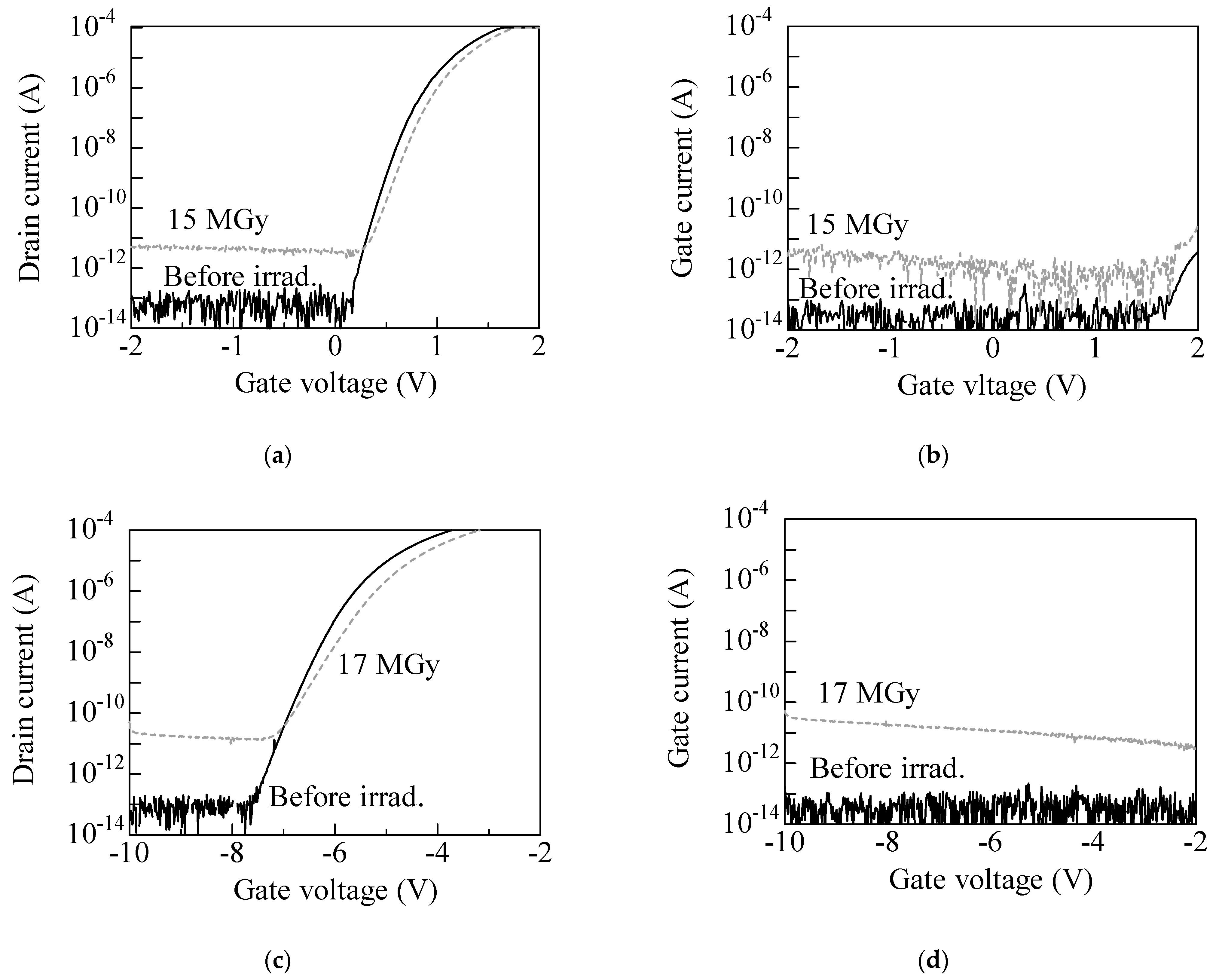
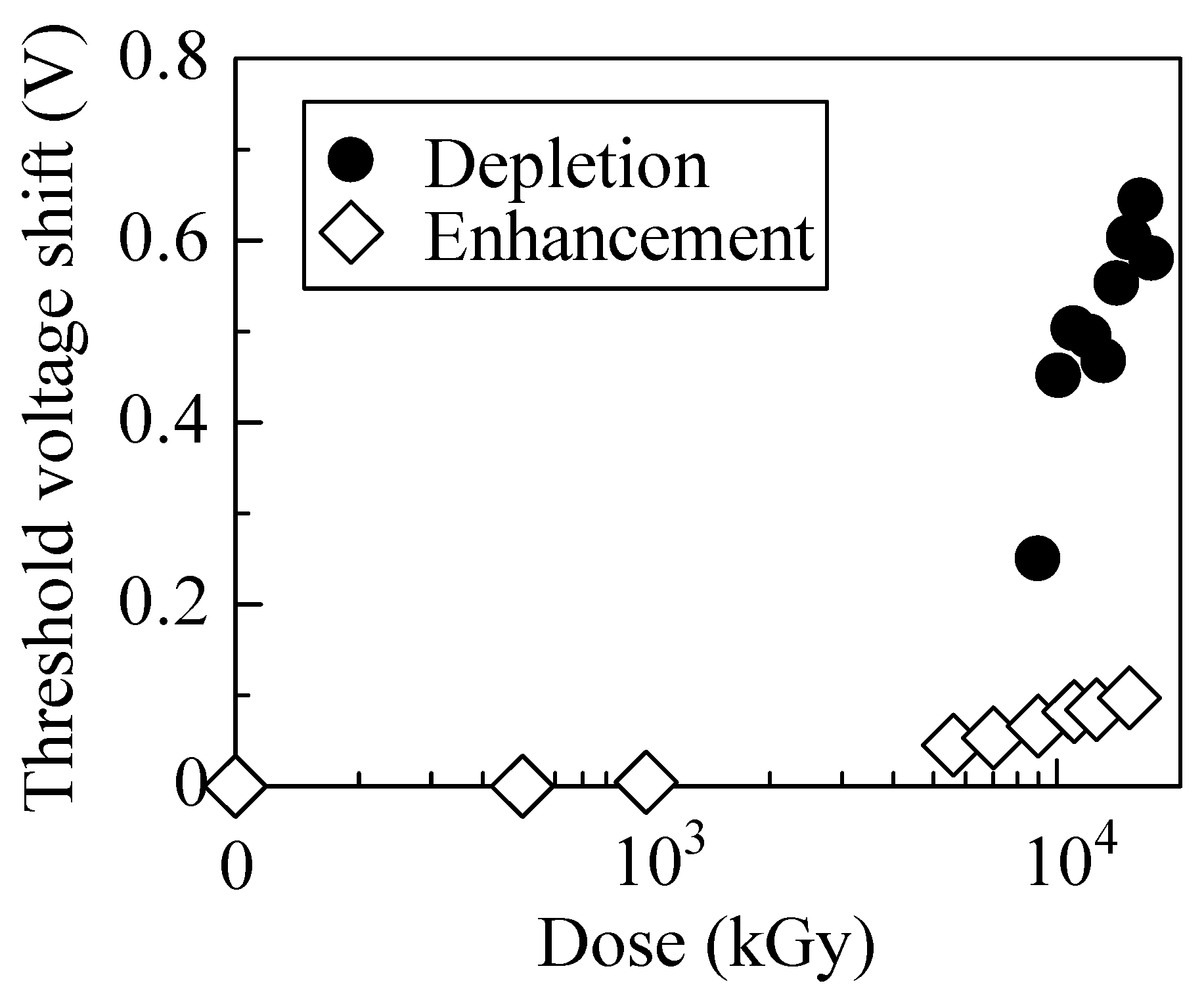

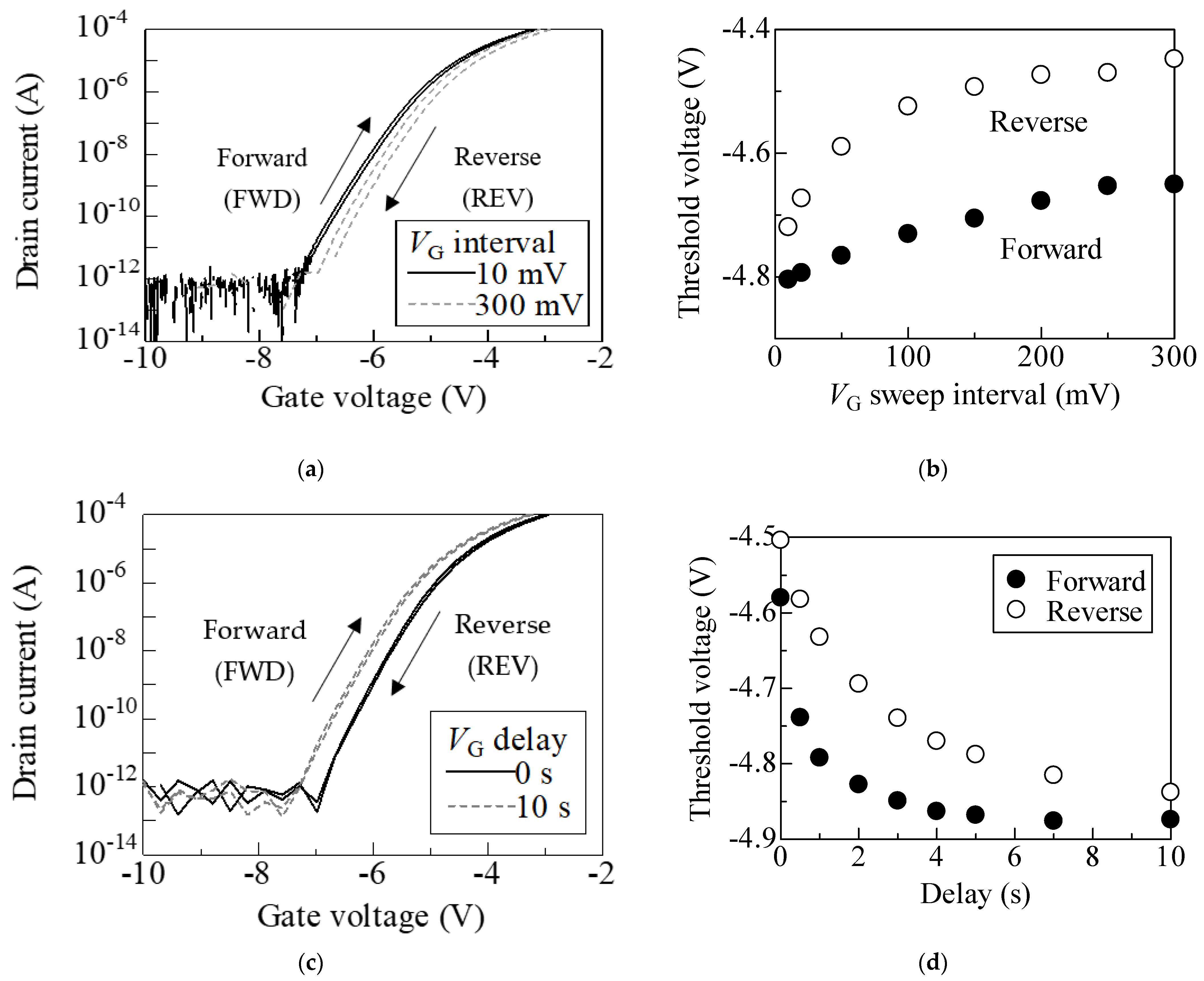
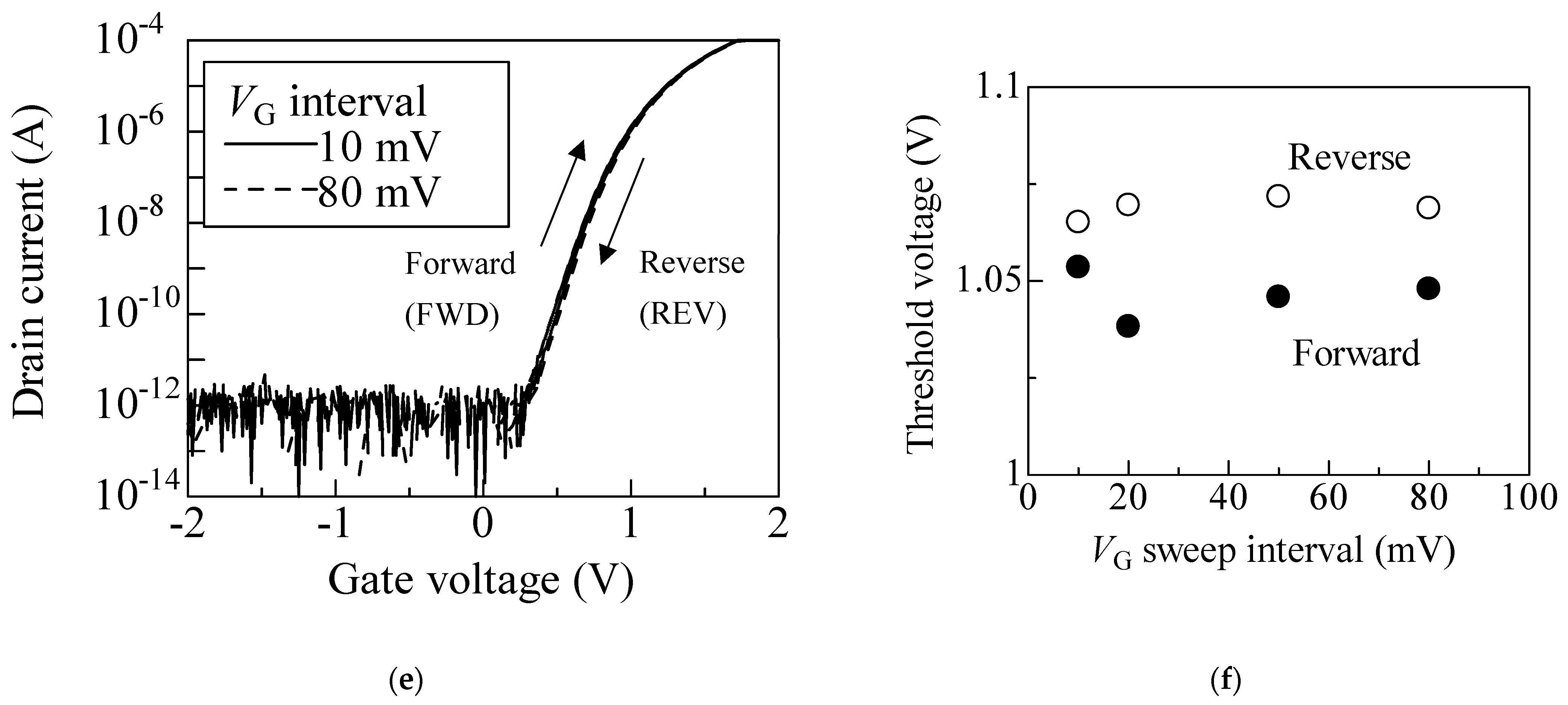
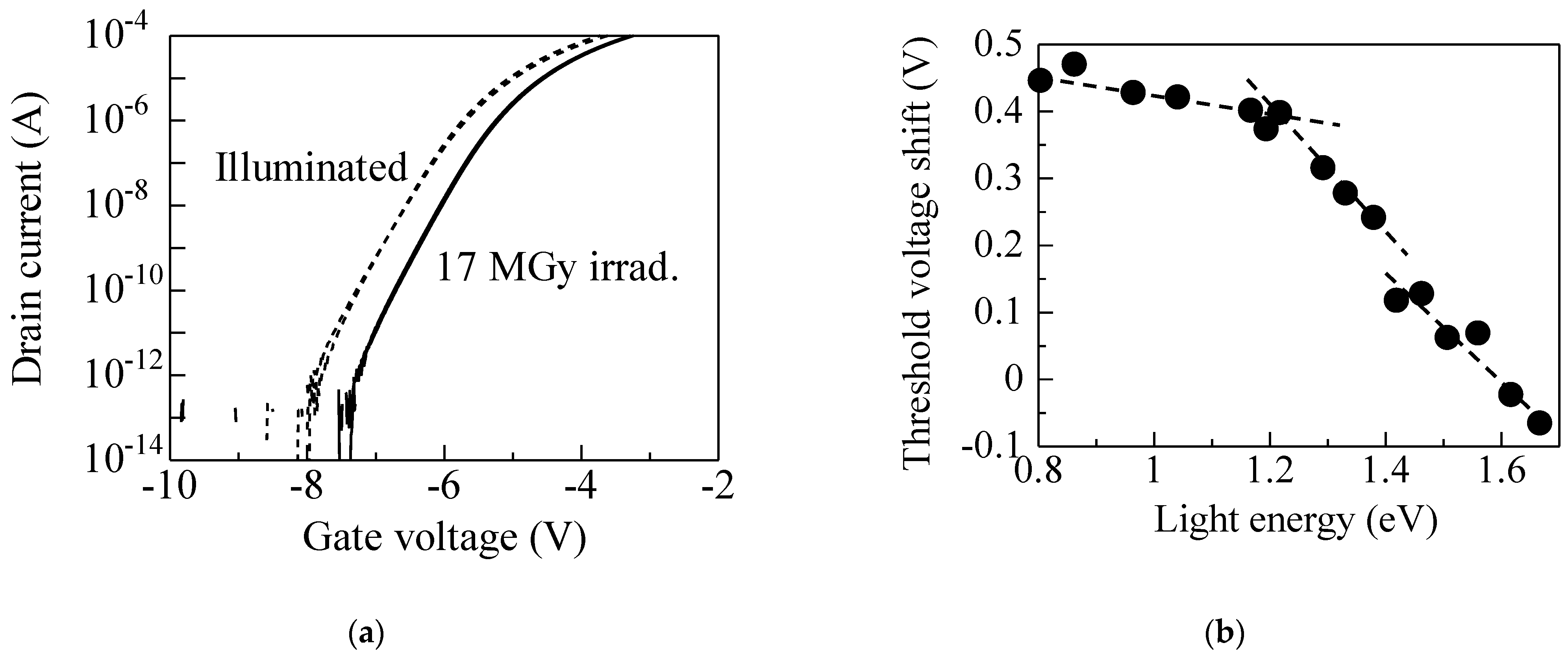

Disclaimer/Publisher’s Note: The statements, opinions and data contained in all publications are solely those of the individual author(s) and contributor(s) and not of MDPI and/or the editor(s). MDPI and/or the editor(s) disclaim responsibility for any injury to people or property resulting from any ideas, methods, instructions or products referred to in the content. |
© 2023 by the authors. Licensee MDPI, Basel, Switzerland. This article is an open access article distributed under the terms and conditions of the Creative Commons Attribution (CC BY) license (https://creativecommons.org/licenses/by/4.0/).
Share and Cite
Takeyama, A.; Makino, T.; Tanaka, Y.; Kuroki, S.-I.; Ohshima, T. Influence of Gate Depletion Layer Width on Radiation Resistance of Silicon Carbide Junction Field-Effect Transistors. Quantum Beam Sci. 2023, 7, 31. https://doi.org/10.3390/qubs7040031
Takeyama A, Makino T, Tanaka Y, Kuroki S-I, Ohshima T. Influence of Gate Depletion Layer Width on Radiation Resistance of Silicon Carbide Junction Field-Effect Transistors. Quantum Beam Science. 2023; 7(4):31. https://doi.org/10.3390/qubs7040031
Chicago/Turabian StyleTakeyama, Akinori, Takahiro Makino, Yasunori Tanaka, Shin-Ichiro Kuroki, and Takeshi Ohshima. 2023. "Influence of Gate Depletion Layer Width on Radiation Resistance of Silicon Carbide Junction Field-Effect Transistors" Quantum Beam Science 7, no. 4: 31. https://doi.org/10.3390/qubs7040031





